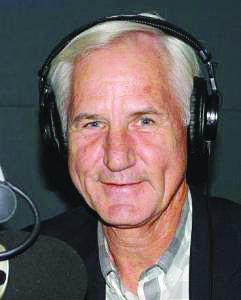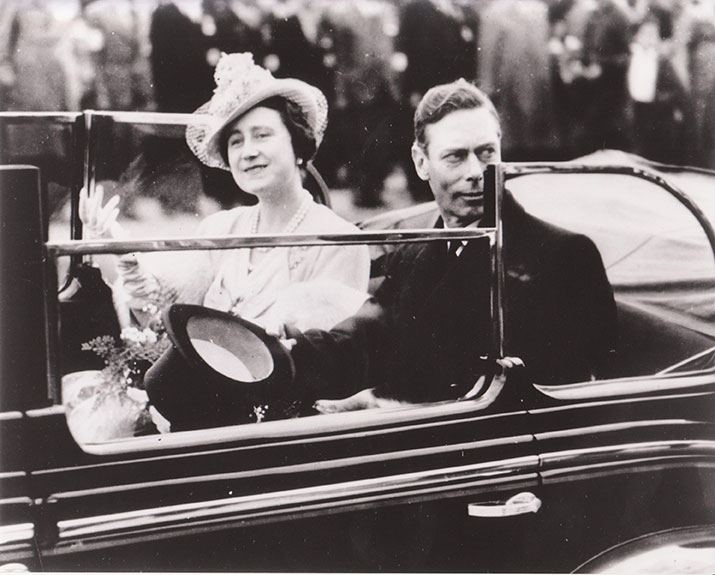2022 marks the 100th anniversary of radio broadcasting in Manitoba. Over the course of the year, Lifestyles 55 will be publishing a series of articles featuring a few of the highlights of local radio history.

King George the VI had good reason to be nervous as he made his way in the rain to Government House, just across from the Manitoba Legislature. The clock was ticking toward 1 p.m. on May 24th, Victoria Day, 1939. The King and Queen Elizabeth were on a cross-Canada tour. The Winnipeg stop was to provide the King with one of his biggest challenges.
King George VI was to address the Commonwealth that day via radio. Public speaking of any kind was not his forte. Since early childhood, George had suffered from a speech disorder characterized by a severe stutter. He was working to overcome the problem, but the prospect of addressing millions around the world must have been daunting.

The Royal visit to Winnipeg in May 1939.
Not only was the speech a challenge for the King, but also for local broadcasters. Nothing was left to chance by technicians from the recently-formed Canadian Broadcasting Corporation and radio station CKY, a CBC affiliate, owned and operated by the Manitoba Telephone System. Coverage of the event was to showcase the merits of public broadcasting.
A makeshift studio was set up in a small room at Government House. “Furnishings in the room will suggest relaxation,” the Winnipeg Tribune informed its readers. Those furnishings amounted to a desk, a chair and two small gold-plated microphones made to CBC specifications. Only one microphone would be used. The other was there in the event of technical difficulties.
In fact, virtually every piece of broadcast equipment had been duplicated to ensure there’d be no last-minute foul up. The King’s voice would travel by telephone line to the CKY headquarters in the Manitoba Telephone System building on east Portage Avenue. From there it would be sent to the main transmitter and then across the CBC radio network. The British Broadcasting Corporation would pick up the signal where it would be broadcast and relayed to countries throughout the Commonwealth.
The King insisted he be in the room alone. Broadcast technicians and most of their equipment waited just outside. A small light would signal the broadcast was underway. Timing was crucial. The one o’clock start in Winnipeg would ensure the speech would be heard in prime time at 8 p.m. o’clock in England.
The monarch spoke slowly and methodically, noting the place had changed a great deal since the time of his great grandmother. “Winnipeg, the city from which I am speaking, was no more than a fort or hamlet on the open prairie when Queen Victoria began to rule. Today it is a monument to the faith and energy which have created and upheld the world wide Empire of our time.”
Local media was consumed with the Royal visit. The speech ran on both Winnipeg radio stations. CKY and the privately-owned CJRC committed their entire broadcast day to Royal Tour coverage. City newspapers were equally enthusiastic. “King George Talks To All The World From Winnipeg,” screamed one Tribune headline. The Free Press estimated a potential radio audience of “500 million”.
For this brief moment in time, Winnipeg was the centre of the radio universe. The fifteen minute broadcast went off without a hitch, representing one of the great technical feats of early radio history. In London, the ailing Queen Mother was reported to have followed the address closely while resting in her bed. Thirteen-year-old Princess Elizabeth listened to her father’s speech in the sitting room at Buckingham Palace.
The King’s Winnipeg broadcast took place three months prior to the radio address dramatized in the 2010 movie “The King’s Speech.” The desk where George VI sat can still be found at the home of the Lieutenant Governor. Whatever happened to the gold-plated microphones he spoke into remains a mystery. They disappeared at some point after the Winnipeg speech, and despite numerous attempts to find them, they have never been located.
Garry Moir has spent more than 50 years in the broadcasting industry. He has written extensively about local radio history including a book titled “On The Air: The Golden Age of Manitoba Radio.” He currently produces the daily “History Vault” feature on CJNU radio.

